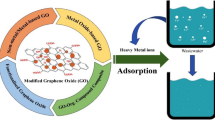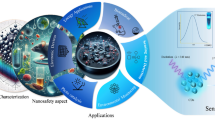Abstract
A novel pH-responsive magnetic graphene oxide composite (MGO@PEI-BA) is proposed for the first time as an adsorbent for the rapid capture and detection of nucleosides (cytidine, uridine, guanosine, and adenosine). The morphology, structure, and magnetic properties of the composite were evaluated using various characterization techniques. The results indicated that the composite was successfully fabricated. A series of parameters that affect extraction and elution were optimized through one-factor-at-a-time and Box-Behnken design of response surface methodology (BBD-RSM). The unique layered structures and easily accessible active sites of the composite facilitated molecular transport, resulting in instantaneous equilibrium of nucleosides adsorption within 5 min. Based on this study, a magnetic dispersive micro-solid-phase extraction (MD-μ-SPE) method assisted by the MGO@PEI-BA was developed in combination with UHPLC-UV analysis for the determination of nucleosides in rat urine. Under the optimum conditions, a wide linear range (10–2000 ng mL−1), good linearity (r > 0.99), low detection limits (1–3 ng mL−1), low relative standard deviations (RSDs ≤ 3.9%), and satisfactory recoveries (82.7–96.3%) were achieved. These results demonstrate that the MGO@PEI-BA is an excellent adsorbent for extracting nucleosides from biological samples.
Graphical Abstract






Similar content being viewed by others
References
Godoy AT, Eberlin MN, Simionato AVC (2020) Targeted metabolomics: liquid chromatography coupled to mass spectrometry method development and validation for the identification and quantitation of modified nucleosides as putative cancer biomarkers. Talanta 210:120640. https://doi.org/10.1016/j.talanta.2019.120640
Ruiz-Mirazo K, Briones C, Escosura A (2014) Prebiotic systems chemistry: new perspectives for the origins of life. Chem Rev 114(1):285–366. https://doi.org/10.1021/cr2004844
Mathé EA, Patterson AD, Haznadar M, Manna SK, Krausz KW, Bowman ED, Shields PG, Idle JR, Smith PB, Anami K, Kazandjian DG, Hatzakis E, Gonzalez FJ, Harris CC (2014) Noninvasive urinary metabolomic profiling identifies diagnostic and prognostic markers in lung cancer. Cancer Res 74(12):3259–3270. https://doi.org/10.1158/0008-5472.CAN-14-0109
Feng S, Zheng Z, Xu Y, Lin J, Chen G, Weng C, Lin D, Qiu S, Cheng M, Huang Z, Wang L, Chen R, Xie S, Zeng H (2017) A noninvasive cancer detection strategy based on gold nanoparticle surface-enhanced raman spectroscopy of urinary modified nucleosides isolated by affinity chromatography. Biosens Bioelectron 91:616–622. https://doi.org/10.1016/j.bios.2017.01.006
Zhou GS, Yuan YC, Yin Y, Tang YP, Xu RJ, Liu Y, Chen PD, Yin L, Duan JA (2020) Hydrophilic interaction chromatography combined with ultrasound-assisted ionic liquid dispersive liquid-liquid microextraction for determination of underivatized neurotransmitters in dementia patients' urine samples. Anal Chim Acta 1107:74–84. https://doi.org/10.1016/j.aca.2020.02.027
Pan Y, Guo X, Li S, Liu X, Zhang H (2018) A boronate-decorated porous carbon material derived from a zinc-based metal–organic framework for enrichment of cis-diol-containing nucleosides. New J Chem 42:2288–2294. https://doi.org/10.1039/C7NJ04575A
Li H, Zhu S, Cheng T, Wang S, Zhu B, Liu X, Zhang H (2016) Binary boronic acid-functionalized attapulgite with high adsorption capacity for selective capture of nucleosides at acidic pH values. Microchim Acta 183:1779–1786. https://doi.org/10.1007/s00604-016-1808-5
Shirani M, Akbari-adergani B, Rashidi Nodeh H, Shahabuddin S (2020) Ultrasonication-facilitated synthesis of functionalized graphene oxide for ultrasound-assisted magnetic dispersive solid-phase extraction of amoxicillin, ampicillin, and penicillin G. Microchim Acta 187:634. https://doi.org/10.1007/s00604-020-04605-z
Chen X, Hai X, Wang J (2016) Graphene/graphene oxide and their derivatives in the separation/isolation and preconcentration of protein species: a review. Anal Chim Acta 922:1–10. https://doi.org/10.1016/j.aca.2016.03.050
Wang Y, Huang Y, Song Y, Zhang X, Ma Y, Liang J, Chen Y (2009) Room-temperature ferromagnetism of graphene. Nano letters 9(1):220–224. https://doi.org/10.1021/nl802810g
Joshi DJ, Koduru JR, Malek NI, Hussain CM, Kailasa SK (2021) Surface modifications and analytical applications of graphene oxide: a review. Trends Anal Chem 144:116448. https://doi.org/10.1016/j.trac.2021.116448
Mourdikoudis S, Kostopoulou A, LaGrow AP (2021) Magnetic nanoparticle composites: synergistic effects and applications. Adv Sci (Weinh) 8(12):2004951. https://doi.org/10.1002/advs.202004951
Chang M, Wang Q, Liu X, Shi X, Xu G (2021) Facile synthesis of antibody-coupled polydopamine-coated magnetic graphene oxide composites for efficient immunopurification and metabolomics analysis of mitochondria. Anal Chem 93(32):11099–11107. https://doi.org/10.1021/acs.analchem.1c01101
Zheng H, Han F, Lin H, Cao L, Pavase TR, Sui J (2019) Preparation of a novel polyethyleneimine functionalized sepharose-boronate affinity material and its application in selective enrichment of food borne pathogenic bacteria. Food Chem 294:468–476. https://doi.org/10.1016/j.foodchem.2019.05.023
Zhao N, Liu Z, Xing J, Zheng Z, Song F, Liu S (2020) Teamed boronate affinity-functionalized branched polyethyleneimine-modified magnetic nanoparticles for the selective capture of ginsenosides from rat plasma. Chem Eng J 383:123079. https://doi.org/10.1016/j.cej.2019.123079
Park CW, Kim BH, Yang HM, Seo BK, Lee KW (2017) Enhanced desorption of Cs from clays by a polymeric cation-exchange agent. J Hazard Mater 327:127–134. https://doi.org/10.1016/j.jhazmat.2016.12.037
Wang S, Cui J, Fan Q, Gan J, Liu C, Wang Y, Yang T, Wang J, Yang C (2022) Reversible and’\ highly Ordered biointerfaces for efficient capture and nondestructive release of circulating tumor cells. Anal Chem 94(26):9450–9458. https://doi.org/10.1021/acs.analchem.2c01743
Li S, Qin Y, Zhong G, Cai C, Chen X, Chen C (2018) Highly efficient separation of glycoprotein by dual-functional magnetic metal-organic framework with hydrophilicity and boronic acid affinity. ACS Appl Mater Interfaces 10(33):27612–27620. https://doi.org/10.1021/acsami.8b07671
Li D, Chen Y, Liu Z (2015) Boronate affinity materials for separation and molecular recognition: structure, properties and applications. Chem Soc Rev 44(22):8097–8123. https://doi.org/10.1039/c5cs00013k
Li H, He H, Liu Z (2021) Recent progress and application of boronate affinity materials in bioanalysis. Trends Anal Chem 140(1):116271. https://doi.org/10.1016/j.trac.2021.116271
Yuan X, Gao X, Yuan Y, Ji Y, Xiong Z, Zhao L (2021) Fe3O4/graphene molecularly imprinted composite for selective separation of catecholamine neurotransmitters and their analysis in rat brain tissues. Talanta 224:121843. https://doi.org/10.1016/j.talanta.2020.121843
Usman MA, Khan AY (2022) Selective adsorption of anionic dye from wastewater using polyethyleneimine based macroporous sponge: batch and continuous studies. J Hazard Mater 428:128238. https://doi.org/10.1016/j.jhazmat.2022.128238
Abdipoor A, Taheri A, Rangin A (2022) New magnetic graphene oxide core–shell functionalized SBA-15 dual template imprinted polymer for μ-solid phase extraction of nortriptyline and amitriptyline in mice plasma. Sep Purif Technol 298:121615. https://doi.org/10.1016/j.seppur.2022.121615
Liu C, Gu C, Huang W, Sheng X, Du J, Li Y (2019) Targeted UPLC-MS/MS high-throughput metabolomics approach to assess the purine and pyrimidine metabolism. J Chromatogr B 1113:98–106. https://doi.org/10.1016/j.jchromb.2019.03.008
Hu Y, Huang Y, Tong Y, Xia Q, Tian M (2017) Boronate-affinity hollow molecularly imprinted polymers for the selective extraction of nucleosides. New J. Chem 41:7133–7141. https://doi.org/10.1039/C7NJ00148G
Fan H, Chen P, Wang C, Wei Y (2016) Zirconium-doped magnetic microspheres for the selective enrichment of cis-diol-containing ribonucleosides. J Chromatogr A 1448:20–31. https://doi.org/10.1016/j.chroma.2016.04.048
Liu D, Meng L, Huang L, Luo S (2020) Preparation of a boronate-affinity monolithic column for adsorption of nucleosides. Anal Methods 12(46):5635–5641. https://doi.org/10.1039/d0ay01860k
Cheng T, Li H, Ma Y, Liu X, Zhang H (2015) Synthesis of boronic-acid-functionalized magnetic attapulgite for selective enrichment of nucleosides. Anal Bioanal Chem 407(12):3525–3529. https://doi.org/10.1007/s00216-015-8550-4
Feng S, Zhang A, Wu F, Luo X, Zhang J (2022) In-situ growth of boronic acid-decorated metal-organic framework on Fe3O4 nanospheres for specific enrichment of cis-diol containing nucleosides. Anal. Chim. Acta 1206:339772. https://doi.org/10.1016/j.aca.2022.339772
He H, Wang Y, Zhou Z, Guo Y, Yan X, Lei Y, Shen X, Liu W, Luo L (2021) Boronate affinity directing adenosine imprinted nanomagnetic polyhedral oligomeric silsesquioxanes for selective extraction of nucleosides in urine sample. Microchem J 169:106575. https://doi.org/10.1016/j.microc.2021.106575
Zhang Q, Zhou DD, Li F, Wang YZ, Yang FQ (2019) Extraction of nucleobases, nucleosides and nucleotides by employing a magnetized graphene oxide functionalized with hydrophilic phytic acid and titanium (IV) ions. Microchim Acta 186:187. https://doi.org/10.1007/s00604-019-3308-x
Funding
This work was supported by the National Natural Science Foundation of China (Nos. 82174235 and 81773694).
Author information
Authors and Affiliations
Corresponding authors
Ethics declarations
Conflict of interest
The authors declare no competing interests.
Additional information
Publisher’s note
Springer Nature remains neutral with regard to jurisdictional claims in published maps and institutional affiliations.
Supplementary information
ESM 1
(DOCX 18721 kb)
Rights and permissions
Springer Nature or its licensor (e.g. a society or other partner) holds exclusive rights to this article under a publishing agreement with the author(s) or other rightsholder(s); author self-archiving of the accepted manuscript version of this article is solely governed by the terms of such publishing agreement and applicable law.
About this article
Cite this article
Yin, H., Yuan, Y., Xin, L. et al. pH-responsive magnetic graphene oxide composite as an adsorbent with high affinity for rapid capture of nucleosides. Microchim Acta 190, 365 (2023). https://doi.org/10.1007/s00604-023-05945-2
Received:
Accepted:
Published:
DOI: https://doi.org/10.1007/s00604-023-05945-2




